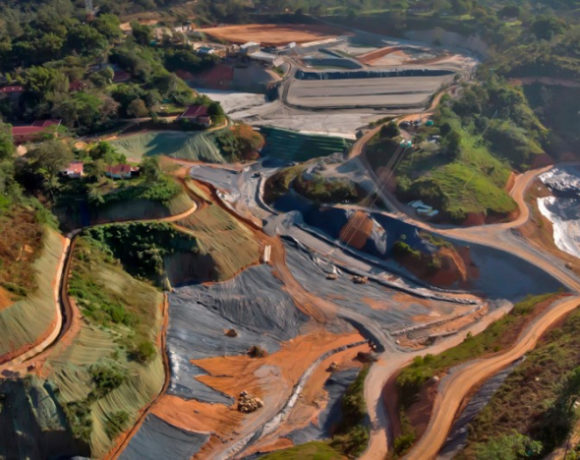Mineros SA 2017 Profits Rise 32% Year-on-Year; Socially Responsible Projects Grow

Medellin-based gold miner Mineros SA announced March 16 that its full-year 2017 net profits in Colombia rose 16% year-on-year, to COP$114.7 billion (US$40 million).
Earnings before interest, taxes, depreciation and amortization (EBITDA) in Colombia hit COP$187.9 billion (US$65.8 million), or 48% of sales.
Corporate-wide, consolidated net income rose 32% year-on-year, to COP$117 billion (US$41 million), while consolidated EBITDA rose 17%, to COP$283 billion (US$99 million).
Total gold output rose 8.7% year-on-year, to 208,054 ounces, while average sale price rose 4.1%, to US$1,250/ounce.
Commenting on the results, Mineros noted that world gold prices at year-end 2017 hit US$1,302 per ounce, up 13% year-on-year; average 2017 gold prices were US$1,257.
Relatively strong gold prices came in reaction to falling values of the U.S. dollar along with international political troubles, including threats of war between the USA and North Korea, the company noted.
Meanwhile, world gold production last year reached a new record of 3,268.7 tons, “marginally higher than that observed in 2016 (3,263 tons),” Mineros noted.
“From the point of view of demand, the global manufacture of jewelry increased by 4% to 2,135.5 tons,” according to Mineros.
“This is the first annual increase in this item since 2013, when the demand for gold for investment fell 23%, passing from 1,595.5 tons in 2016 to 1,231.9 tons in 2017.
“Central banks continued to increase their gold reserves for the eighth consecutive year, but at a slower pace than the one observed the previous year, buying 371.4 tons compared to the 389.8 tons purchased in 2016.
“The demand for gold for the technology industry and for dentistry increased 3% compared to that observed in 2016, going from 323.4 to 332.8 tons. These changes generated a net reduction in demand close to 7%, going from 4,378.20 tons in 2016 to 4,071.7 tons in 2017,” Mineros noted.
In Colombia, Mineros SA’s mainly alluvial gold production remained flat year-on-year, at 89,709 ounces. Underground gold production in Colombia fell 14% year-on-year, to 13,664 ounces.
In Nicaragua, production at its Hemco subsidiary rose 22% year-on-year, to 104,681 ounces of gold equivalent, according to the company. Mineros added that in 2018, the company will concentrate greenfield exploration mainly in Nicaragua.
Socially Responsible Mining
Meanwhile, Mineros continues to support environmentally and socially responsible mining in Colombia – in part by eliminating toxic mercury from is mainly alluvial operations, in contrast to criminal and reckless mining practiced by others.
Among Mineros social-environmental projects in 2017:
1.A “business strengthening” program, which last year provided financial credits and consulting to 25 entrepreneurial companies, “aimed at developing skills that not only help them to be better entrepreneurs but also better citizens.”
2. Apicultural production project: This program – supported in part by the U.S. Agency for International Development’s “Legal Gold” program — continues to grow, with 100 families associated to the ASAPIBAS (Association of Beekeepers of the Lower Cauca and Southern Bolivar) cooperative in 20 villages near El Bagre, Nechí, Zaragoza, Anorí and Caucasia, Antioquia. These cooperatives produced 13 tons of honey last year, netting close to COP$271 million (US$95,000) in supplemental income.
These families also recently founded three laboratories for the production of bee-biological nuclei, “in order to continue growing and populating their apicultural units. Also, 120 new hectares were reforested in order to increase the floral supply available, while also serving as an environmental contribution for the region, rehabilitating areas [wrecked] by informal mining,” the company added.
3. Business and human rights project with the United Nations: “We continue supporting the Office of the United Nations High Commissioner for Human Rights in actions for the construction of peace and citizen coexistence” in mining areas, Mineros noted.
This project “supported the training of 50 members of the Committees of Coexistence of El Bagre that participate in the formulation of development programs with a territorial approach, while six education and recreation campaigns were carried out to generate bonds of trust, confidence and coexistence in neighborhoods of El Bagre and Zaragoza.”
4. Mining legalization: In 2017, Mineros provided technical-assistance loans to the informal miner group EMIJOM (Empresa de Mineros de Jobo Medio-Emijom) “for the improvement of ore beneficiation processes, in order to increase gold recovery and avoid the use of mercury.”
5. Wetlands program: During 2017, Mineros helped clean 14 hectares of water and water-supply access pipes in natural marshes, working jointly with the communities of Sabalito Sinaí, Guamo-Guachí, El Pital, San Pedro and La Esperanza.
“In the same way, the community of Puerto Gaitán worked on cleaning the waters of the La Esperanza swamp,” with Mineros payments for this project generating extra income for local workers while also boosting environmental protection, the company added.
6. Conservation of river turtles: “In 2017, communities from the municipalities of Nechí, Zaragoza, Caucasia and El Bagre participated in nine conservation-center operations, achieving the release of 1,300 individuals of this species,” according to Mineros.
7. Fish farming and repopulation program: “Fulfilling the environmental management plan, during 2017 the repopulation of the Bocachico species was continued — considered of great importance in the diet of the riverside populations and also because Bocachico is classified as an endangered species. With the participation of the fishing communities of Nechí and the National Authority of Aquaculture and Fisheries (AUNAP), we introduced 500,000 Bocachico fingerlings in strategic wetlands including La Taburetera, El Sapo, Corrales and La Esperanza,” according to Mineros.
8. Reforestation program: “In 2017, we planted about 120,000 trees of different native species on 60.5 hectares of land left behind after the alluvial operation (involving hydraulic landfills),” the company noted.
9. Agroforestry plots: This program added 48 more plots in 2017, “all built in the recovery zones left by the [alluvial] production units. In agroforestry systems, there are about 750 hectares [of reforested plots], where honey is produced, along with yam, yucca, banana, corn, rice, fruit and vegetables in home gardens. These activities are complemented with artisanal fishing, poultry, pigs, rams and cattle,” according to Mineros.
10. Rubber plantations: As of 2017, “the population of rubber trees planted amounted to 450,000 trees in about 1,000 hectares. Of these, the first 28,000 trees entered latex production,” the company added.
















